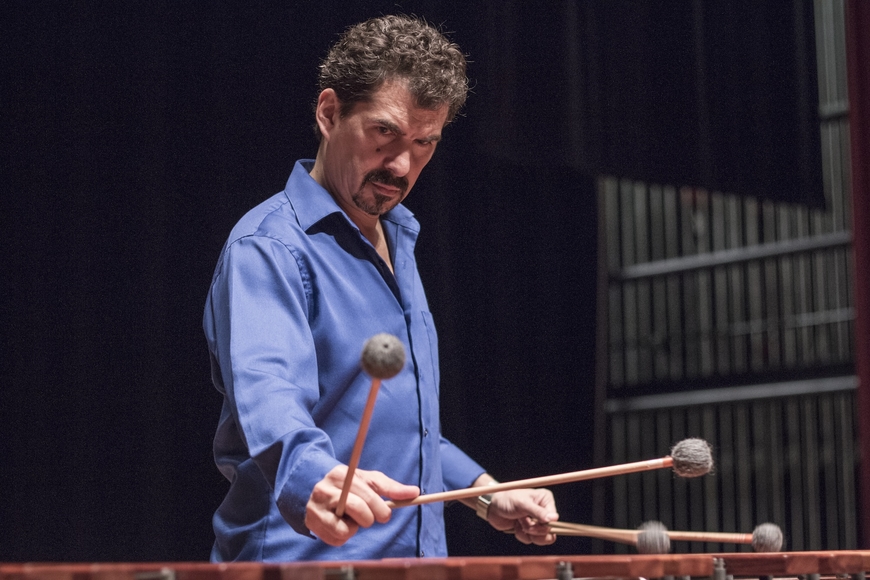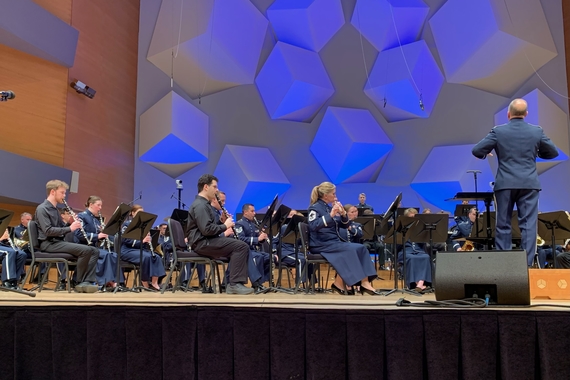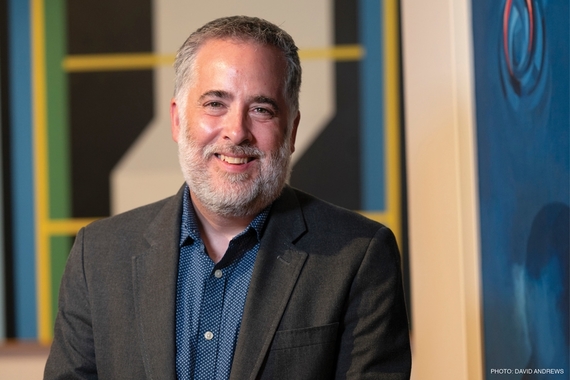Sharing in the Joy of Teaching Music
Professor Fernando Meza has been at the helm of the University of Minnesota School of Music’s percussion studio for 30 years. The proof of his passion for percussion education shines in his successful alumni with diverse careers, ranging from music educators across Minnesota and the nation, to touring the world with top musical groups. How did Meza develop the percussion program to the world-class experience that it is today? We caught up with him to learn how his dream of teaching and professional performance background nurtures the development of students in his studio.
Can you share more about your teaching philosophy with your studio students? How do you help prepare a student to move on to their professional career?
I have a wide variety of students in my studio. Some are pursuing careers in the performance arena, others as future music educators or music therapists, and yet others are pursuing other degrees or doing a double degree in music and another discipline. Whatever area of musical study they pursue, however, my teaching philosophy is ruled by the same principle, which is a passion for the study of this art form. I try to share my personal passion for music with them while at the same time engaging in discovering where their own passion resides in this field of study so I can help nurture and challenge that as their mentor. I want my students to be able to function independently and not base their thinking on what I, or anyone else for that matter, might tell them they “should” or “should not” do. In order to encourage that independent thought process, I work on challenging them to think clearly and thoroughly about their decision-making process so they can develop their personal skills in a uniquely individual way which will serve them fully in their future professional careers. In other words, I try to challenge their thinking while nurturing their passion and then I get out of the way so their own magic can happen!
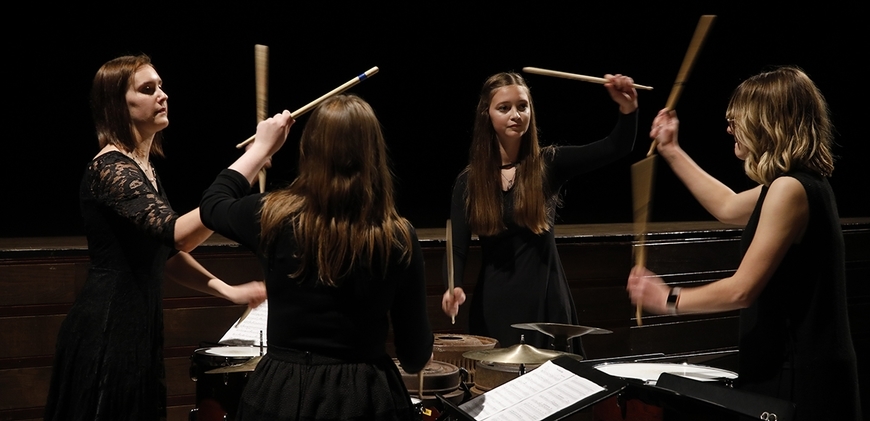
What aspect/s about the School of Music, University of Minnesota and the Twin Cities area have made it your home for the past 30 years?
There are many things that have made this place home for me since my arrival here in 1993. The University of Minnesota provided a place for me to dream about a program that could raise the level of musical excellence in percussion performance and education in this state, and the School of Music supported that vision with excellence throughout its offerings. My students have been the recipients of that vision over the years, which was both individual (on my side) and collective (through my colleagues’ work) and the lining up of those elements have certainly made it feel like this is the place I have belonged throughout my teaching career during these past 30 years. Alongside the professional culmination of long-held dreams of sharing in the joy of teaching music at a nationally recognized School of Music, the Twin Cities also provided a place for me to raise a family in a culturally-rich environment and it certainly created a home for all of us.
What has been your top career milestone moment so far?
That’s a very difficult question to answer as there have been many special moments professionally for me over the years. Performances with the Minnesota Orchestra at the Berlin Philharmonie, Vienna’s Musikverein or Carnegie Hall for example, and tours with them in Europe, Cuba and South Africa, stand out as uniquely special moments for me. Equally however, having been one of the five original percussionists for Disney’s Broadway production of The Lion King, or performing as soloist with the National Symphony of my home country of Costa Rica are very special moments in my career. If I had to pin a milestone per se, I would probably have to say that my collaborations with the Japanese marimba artist Keiko Abe have to stand as truly important imprimaturs in my career (and yes, I know that’s not one milestone but several!). Ms. Abe has long been considered the most influential marimba artist of our generation and having had the privilege of sharing the stage with her on tour in Japan, the USA and Costa Rica, as well as having recorded with her in Japan, certainly stand out as some of my most profoundly moving and memorable experiences. Others, such as conceiving the idea for and organizing/hosting the Marimba 2010: International Festival and Conference right here in the Twin Cities; and participating as the percussion faculty member for the Orchestra of the Americas during the summers since 2003 also have a very special place in my heart.
Over the years, there’s been multiple unique projects that your studio has produced, including an international video collaboration with students from Costa Rica. How do you continue to reinvent your teaching style when new generations of students come in, and new technology emerges?
Musicians are nothing if not artistically adaptable creatures, and percussionists are certainly nothing if not musical chameleons, as we are exposed to music of all kinds all the time. It is important for me to be able to function professionally as well as to teach, in a way that brings the wide variety of possibilities the world has to offer musically to our direct surroundings. Students come into my studio every year with fresh ideas, perspectives, and goals, and it is my job to learn how to shape their inquisitiveness and my experience into a system that will inspire life-long learning for everyone. Technology has certainly helped in closing some gaps that existed previously, such as physical distance, and it has made it possible to investigate new and interesting options, as in the case of the video collaboration our percussion studio did with our counterparts at the University of Costa Rica. Of course, the closing of that gap allows for many other possibilities, such as bringing in guest artists online to share and teach, as was the case during the pandemic, when I brought in around 20 different colleagues to share with my students from places as far as Japan, Germany, France, Costa Rica, Croatia, Taiwan, and others. The many benefits my students reaped from those sessions still have repercussions today, including professional connections which some of my now alumni have been able to take advantage of in their own careers.
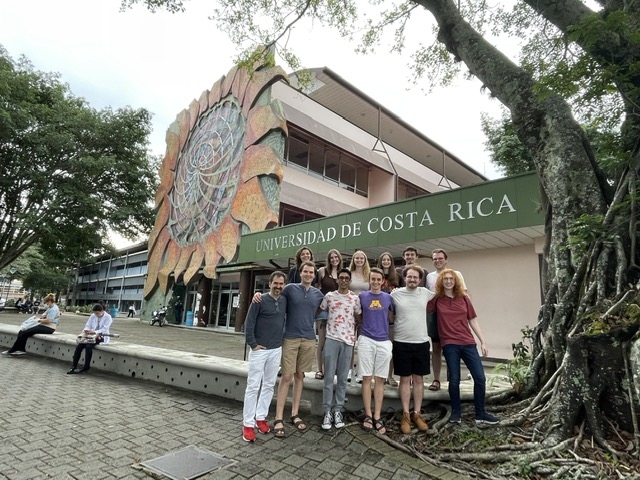
You’ve been on several international trips with your percussion studio over the years, what has been the most impactful destination to take your students to?
I have taken 6 different groups of students to Costa Rica during my tenure at the University of Minnesota, all to great acclaim and success, and with life-long and impactful experiences for my students. Costa Rica has been a special place to take them to, not only because it’s the place where I grew up and where I have a great deal of memories, friends and connections, but also because the quality of percussion in this small Central American country is very high. Most of my students have never been to Costa Rica and therefore have not known what to expect of these trips, and upon arrival there quickly realize that there is much to be learned as well as shared, so on both musical and personal levels, the experiences have always been deeply important for them, as have been of course for me. I believe this to be the real meaning of our efforts to internationalize our curriculum and offerings, and hope to do more of them in the future.
What is your favorite style of percussion to teach and why?
Percussion is a very wide field of musical inquiry. From traditional art forms, musical styles, and instruments used in particular cultures (tabla in India, taiko drumming in Japan, steel pan in Trinidad & Tobago, djyl, kalimba, and djembe in Africa among many others, congas, bongó, and timbales in Cuba, samba in Brazil, etc), to more widely known musical offerings such as orchestral, chamber music, and jazz, percussion instruments are present in every corner of the world and in every musical style imaginable. When asked this question, or perhaps one asking me to name my favorite percussion instrument, I often answer the same way: “The one in front of me!” as I am just as engaged in the process of finding the perfect sound for one triangle note for an orchestral piece, as I am in a complex multiple-percussion composition involving a wide array of instruments. In the same way, I want to understand the particular character for a unique style of music or a cultural/technical element for an instrument. All of these elements fuel my imagination, creativity and my inner child’s desire to discover. Because of the endless variety in the percussion field, there is never a dull moment on either side of my career (performing and/or teaching), as I am constantly engaged with new materials on both sides. With my students, the wide availability of compositions, musical styles, techniques, and cultural elements waiting to be explored and discovered through percussion study, as well as the pedagogical paths I need to navigate in order to help them make the best of their own journey, coupled with the unique challenges and experiences I encounter daily in my own performance world, make it basically impossible to get bored, since there are endless roads to take intellectually and artistically each day.
What do you wish potential students to know about the professional percussion industry?
The percussion field is incredibly wide, rich, and varied, and there are many potential opportunities out there for those searching for them. My main hope for my students of course, is that they are able to fulfill their dreams as they envision them. However, and as we all know well, life does not come with a manual nor does it always go as planned or hoped for, and we must be ready to adapt to the circumstances. Be prepared and be ready for the moment when opportunity knocks on your door so you can open that door widely and let that opportunity into your life, and also expect that unexpected turns will happen and embrace them, as they may lead you in previously unknown directions which might yield some amazing experiences for you in the future. With as rich an environment as we have in the percussion arena, if you are prepared, you will certainly find a way to lead a fulfilling and equally rich life artistically, pedagogically, commercially, and/or culturally. Just prepare yourself during your student years as thoroughly and conscientiously as you can so that when you join the professional ranks, you are truly ready to face the many opportunities that will come your way!
Are there any upcoming projects that you’re excited about?
I am looking forward to being able to learn a lot of new chamber music during my upcoming sabbatical semester during Spring 2024. Having a busy daily professional schedule does not always allow for the necessary time to invest in cultivating new repertoire and I’m very excited to have the luxury of time to put into the learning of new music and future projects in which to bring this music to share with colleagues, new and old, around the world. I am also excited to dig deeper into the learning of Latin music and traditional marimba music in Costa Rica during that time and to sharing all of that with my students in the near future.
